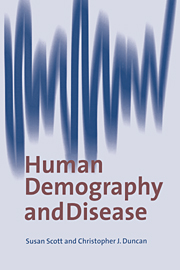Book contents
- Frontmatter
- Contents
- Preface
- Conversion table for imperial to metric units
- 1 Introduction
- 2 Tools for demography and epidemiology
- 3 Identification of population oscillations: a case study
- 4 Density-dependent control and feedback
- 5 Modelling the endogenous oscillations and predictions from timeseries analysis
- 6 Cycles in the grain price series
- 7 Interactions of exogenous cycles: a case study
- 8 Mortality crises and the effects of the price of wool
- 9 Modelling epidemics for the demographer: the dynamics of smallpox in London
- 10 Non-linear modelling of the 2-yearly epidemics of smallpox: the genesis of chaos?
- 11 Measles and whooping cough in London
- 12 Integration of the dynamics of infectious diseases with the demography of London
- 13 Smallpox in rural towns in England in the 17th and 18th centuries
- 14 Infectious diseases in England and Wales in the 19th century
- 15 Prospectives – towards a metapopulation study
- References
- Index
15 - Prospectives – towards a metapopulation study
Published online by Cambridge University Press: 25 January 2010
- Frontmatter
- Contents
- Preface
- Conversion table for imperial to metric units
- 1 Introduction
- 2 Tools for demography and epidemiology
- 3 Identification of population oscillations: a case study
- 4 Density-dependent control and feedback
- 5 Modelling the endogenous oscillations and predictions from timeseries analysis
- 6 Cycles in the grain price series
- 7 Interactions of exogenous cycles: a case study
- 8 Mortality crises and the effects of the price of wool
- 9 Modelling epidemics for the demographer: the dynamics of smallpox in London
- 10 Non-linear modelling of the 2-yearly epidemics of smallpox: the genesis of chaos?
- 11 Measles and whooping cough in London
- 12 Integration of the dynamics of infectious diseases with the demography of London
- 13 Smallpox in rural towns in England in the 17th and 18th centuries
- 14 Infectious diseases in England and Wales in the 19th century
- 15 Prospectives – towards a metapopulation study
- References
- Index
Summary
Time-series analysis is a valuable technique for historical demographers in their studies of population cycles and the epidemiology of diseases. This statistical technique can be applied to runs of data, including parish register series, commodity prices, Bills of Mortality and meterological records and the significance of their cross-correlation can be determined. We have shown how both endogenous and exogenous oscillations can be uncovered by this means in single populations (section 3.5). Matrix modelling of a community maintained in steady-state suggests that synchronous, long wavelength cycles in births and deaths (section 4.1) are endogenous and dependent on the inherent properties of the system and are triggered by a mortality crisis. Such endogenous cycles, which have been detected in different populations probably living under density-dependent constraints, appear to have a wavelength of about 43 or 44 years which reflects the interaction of the demographic parameters and the dynamics of the population (i.e. the fertility function and the gain of the feedback; see section 5.5).
In contrast, short wavelength, exogenous, mortality cycles can be detected quite commonly in the dynamics of many populations; infant, child and adult burial series probably oscillate independently but all three are driven, either directly or indirectly (via effects in pregnancy, section 7.7), by commodity prices, usually the price of grain (Chapter 7). Severe mortality crises were produced in communities in the northwest when the adverse effects of two commodities synchronised and interacted synergistically (Chapter 8). The exogenous short wavelength oscillation in births is driven by the mortality oscillation but is exactly out of phase, in accordance with the predictions from matrix modelling (section 7.8).
- Type
- Chapter
- Information
- Human Demography and Disease , pp. 321 - 334Publisher: Cambridge University PressPrint publication year: 1998



